Land Use and Land Cover Changes and Prediction Based on Multi-Scenario Simulation: A Case Study of Qishan County, China
Abstract
:1. Introduction
2. Material & Method
2.1. Study Area
2.2. Data Source
2.3. Methodology
2.3.1. Technical Pathway
2.3.2. Present Situation Analysis
2.3.3. Model Establishment
2.3.4. Multi-Scenario Prediction
3. Results and Analysis
3.1. Land Use Change Analysis
3.1.1. Characteristics of Dynamic Changes in Land Use
3.1.2. Changes in Land Use Types
3.2. Establishment of the LUCC Model
3.2.1. Construction of the CA-Markov Model
3.2.2. Construction of the LCM Model
3.2.3. Comparison of Model Accuracy
3.3. Multi-Scenario Prediction of Land Use
4. Discussion
5. Conclusions
Author Contributions
Funding
Data Availability Statement
Acknowledgments
Conflicts of Interest
References
- Jin, G.; Chen, K.; Liao, T.; Zhang, L.; Najmuddin, O. Measuring ecosystem services based on government intentions for future land use in Hubei Province: Implications for sustainable landscape management. Landsc. Ecol. 2021, 36, 2025–2042. [Google Scholar] [CrossRef]
- Hu, Y.F.; Zhang, Y.Z.; Han, Y.Q. Identification and monitoring of desertification lands in China from 2000–2015. Arid. Land Geogr. 2018, 41, 1321–1332. [Google Scholar]
- Kolios, S.; Stylios, C.D. Identification of land cover/land use changes in the greater area of the Preveza peninsula in Greece using Landsat satellite data. Appl. Geogr. 2013, 40, 150–160. [Google Scholar] [CrossRef]
- Shen, G.; Yang, X.C.; Jin, Y.X.; Luo, S.; Xu, B.; Zhou, Q.B. Land use changes in the Zoige Plateau based on the object-oriented method and their effects on landscape patterns. Remote Sens. 2020, 12, 14. [Google Scholar] [CrossRef]
- Wu, T.S.; Feng, F.; Lin, Q.; Bai, H.M. A spatio-temporal prediction of NDVI based on precipitation: An application for grazing management in the arid and semi-arid grasslands. Int. J. Remote Sens. 2020, 41, 2359–2373. [Google Scholar] [CrossRef]
- Zhao, D.Y.; Xiao, M.Z.; Huang, C.B.; Liang, Y.; Yang, Z.T. Land use scenario simulation and ecosystem service management for different regional development models of the Beibu Gulf Area, China. Remote Sens. 2021, 13, 3161. [Google Scholar] [CrossRef]
- Chen, Z.Z.; Huang, M.; Zhu, D.Y.; Altan, O. Integrating remote sensing and a Markov-FLUS model to simulate future land use changes in Hokkaido, Japan. Remote Sens. 2021, 13, 2621. [Google Scholar] [CrossRef]
- Liu, X.Q.; Liu, L. Ecological Function of Urban Green Roof and Analysis of Its Influencing Factors. Agric. Sci. Technol. 2017, 18, 2583–2586. [Google Scholar]
- Chi, Z.Y. Study on Land Use Change in Upper Nenjiang River Basin Based on Logistic-Ca-Markov Model; Harbin Normal University: Harbin, China, 2020. [Google Scholar]
- Wu, J.J. Simulation of Land Use Change and Evaluation of Eco-Environmental Effects in the Lower Reaches of Wujiang River Based on GIS and CA-Markov Model; Southwest University: El Paso, TX, USA, 2017. [Google Scholar]
- Xiao, L. Scenario Simulation of Land Use Change in the Basin of Fuxian Lake Based on Ca-Markov Model; Kunming University of Science and Technology: Kunming, China, 2017. [Google Scholar]
- Xu, X.J.; Liu, H.Y.; Lin, Z.S.; Liu, J.X.; Li, L.H. Scenario Analysis of Land Use Change in Jiangsu Coast Based on CA-Markov Model. Res. Soil Water Conserv. 2017, 24, 213–218, 225. [Google Scholar]
- Wu, K.; Li, Y.C. Research progress of urban land use and its ecosystem services in the context of urban shrinkage. J. Nat. Resour. 2019, 34, 1121–1134. [Google Scholar] [CrossRef]
- Wu, K.; Qi, W. Shrinking cities: Misunderstandings, identifications and reflections. Geogr. Res. 2021, 40, 213–229. [Google Scholar]
- Yang, F. Exploration and thinking on the carrying capacity of water resources in Qishan County. Shaanxi Water Resour. 2020, 10, 27–28, 33. [Google Scholar]
- Rong, Y.J.; Zhang, H.; Zhao, X.F. Evaluation of ecological sensitivity of land use in Jiaxing city based on MCE-CA model. J. Agric. Resour. Environ. 2015, 32, 343–353. [Google Scholar]
- Wang, Q.; Meng, J.J.; Mao, X.Y. Scenario simulation and landscape pattern assessment of land use change based on neighborhood analysis and auto-logistic model: A case study of Lijiang River Basin. Geogr. Res. 2014, 33, 1073–1084. [Google Scholar]
- Zhang, H.Y. Fan Jiangwen, Shao Quanqin. Land use/land cover change in the grassland restoration program areasin China, 2000–2010. Prog. Geogr. 2015, 34, 840–853. [Google Scholar]
- Huang, D.; Li, R.D.; Qiu, J. Analysis on spatio-temporal variation of land use and its policy-driven factors in Wuhan metropolitan area. J. Geo-Inf. Sci. 2017, 19, 80–90. [Google Scholar]
- Feng, R.; Xu, L.L.; Zhang, L.; Liu, X. Spatio-temporal Analysis of Land Use Change in Mudanjiang City Based on Geographical National Conditions Monitoring. Geomat. Spat. Inf. Technol. 2022, 45, 150–154. [Google Scholar]
- Wu, R.; Wang, Y.; Zhang, X.D.; Li, X.M.; Wang, G.L. Study on dynamic change and driving mechanism of land use types in Hebei province. J. Liaoning Norm. Univ. (Nat. Sci. Ed.) 2022, 45, 252–259. [Google Scholar]
- Yang, X.; Zheng, X.; Chen, R. A Land Use Change Model: Integrating Landscape Pattern Indexes and Markov-ca. Ecol. Model. 2014, 283, 1–7. [Google Scholar] [CrossRef]
- Han, L. The classification model of RS images based on artificial neural network—MLP. Bull. Surv. Mapp. 2004, 9, 29–42. [Google Scholar]
- Lin, J. Study on Land Use Change and Its Simulation Based on the MLP-CA-Markov Model in Jinjiang City; Fujian Nomal University: Fujian, China, 2014. [Google Scholar]
- Jamali, A. Land use land cover mapping using advanced machine learning classifiers: A case study of Shiraz city, Iran. Earth Sci. Inform. 2020, 13, 1015–1030. [Google Scholar] [CrossRef]
- Wei, L.L. Land Use Change Prediction Based on IDRISILCM Model-Case Study of the Zhuanghe City; Liaoning Normal University: Dalian, China, 2015. [Google Scholar]
- Nourqolipour, R.; Shariff, A.R.B.M.; Balasundram, S.K.; Ahmad, N.B.; Sood, A.M.; Buyong, T.; Amiri, F. A Gis-based model to analyze the spatial and temporal development of oil palm land use in Kuala Langat District, Malaysia. Environ. Earth Sci. 2015, 73, 1687–1700. [Google Scholar] [CrossRef]
- Song, Y.; Zhu, D.L.; Yeung, G.; Xu, Y.; Zhang, L.X. Spatio-temporal evolution and driving mechanism of urban land use structure with the context of urban shrinkage:Evidence from Northeast China. Geogr. Res. 2021, 40, 1387–1403. [Google Scholar]
- Xu, H.X.; Liu, Y.J. Spatiotemporal differentiation and influencing mechanism of construction land use efficiency of shrinking cities: A case study of Yichun city of Heilongjiang province. J. Environ. Manag. 2021, 40, 937–947. [Google Scholar] [CrossRef]
- Pang, G.W. Quantitative Characterization of Human Factors Effecting the Soil Erosion Environmental. Master’s Thesis, Graduate University of Chinese Academy of Sciences, Beijing, China, 2012. [Google Scholar]
- Shi, P.J.; Bai, X.M.; Kong, F.; Fang, J.Y.; Gong, D.Y.; Zhou, T.; Guo, Y.; Liu, Y.S.; Dong, W.J.; Wei, Z.G.; et al. Urbanization and air quality as major drivers of altered spatiotemporal patterns of heavy rainfall in China. Landsc. Ecol. 2017, 32, 1723–1738. [Google Scholar] [CrossRef]
- Gong, B.H.; Liu, Z.F. Assessing impacts of land use policies on environmental sustainability of oasis landscapes with scenario analysis: The case of northern China. Landsc. Ecol. 2020, 36, 1913–1932. [Google Scholar] [CrossRef]
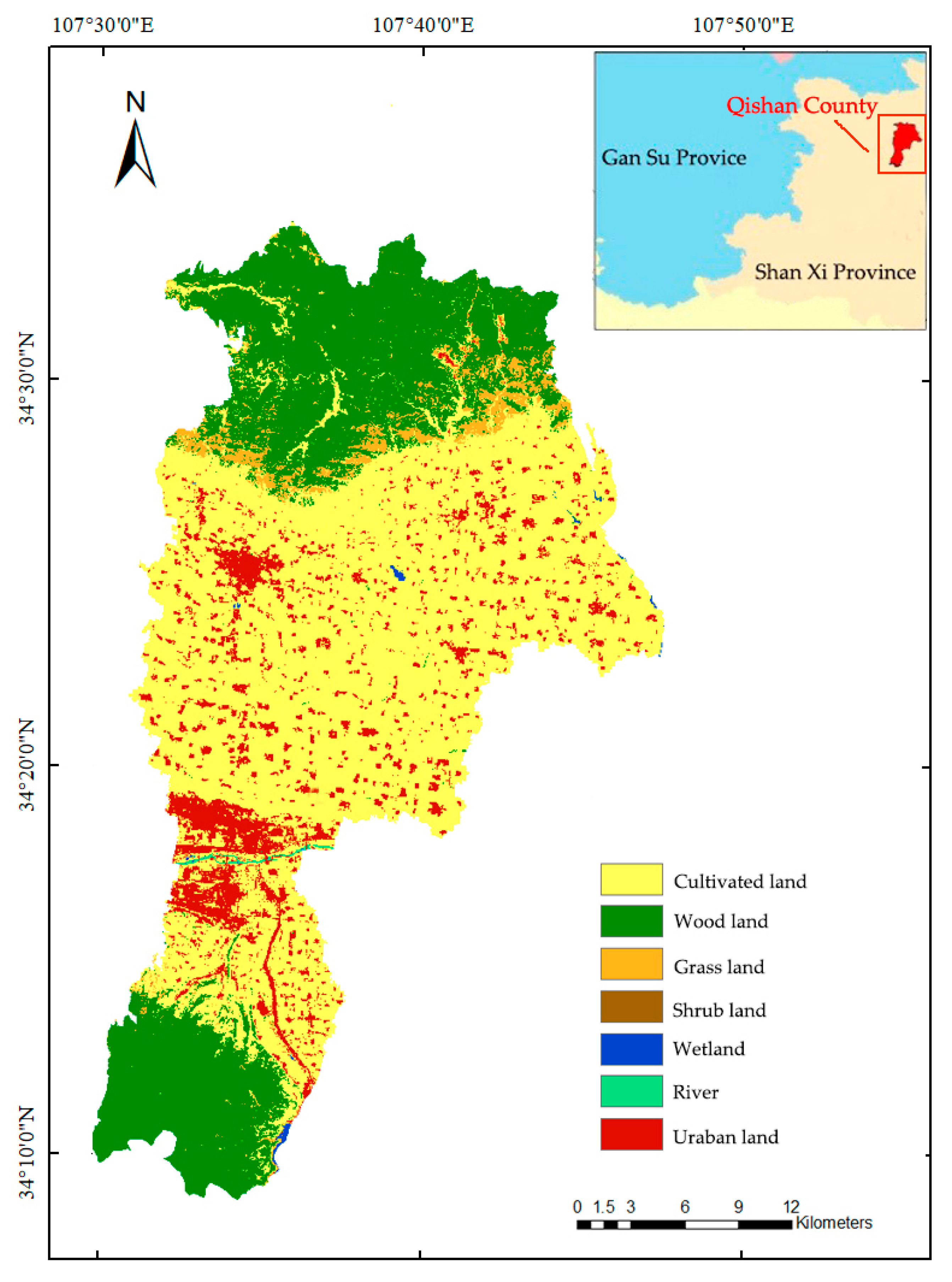
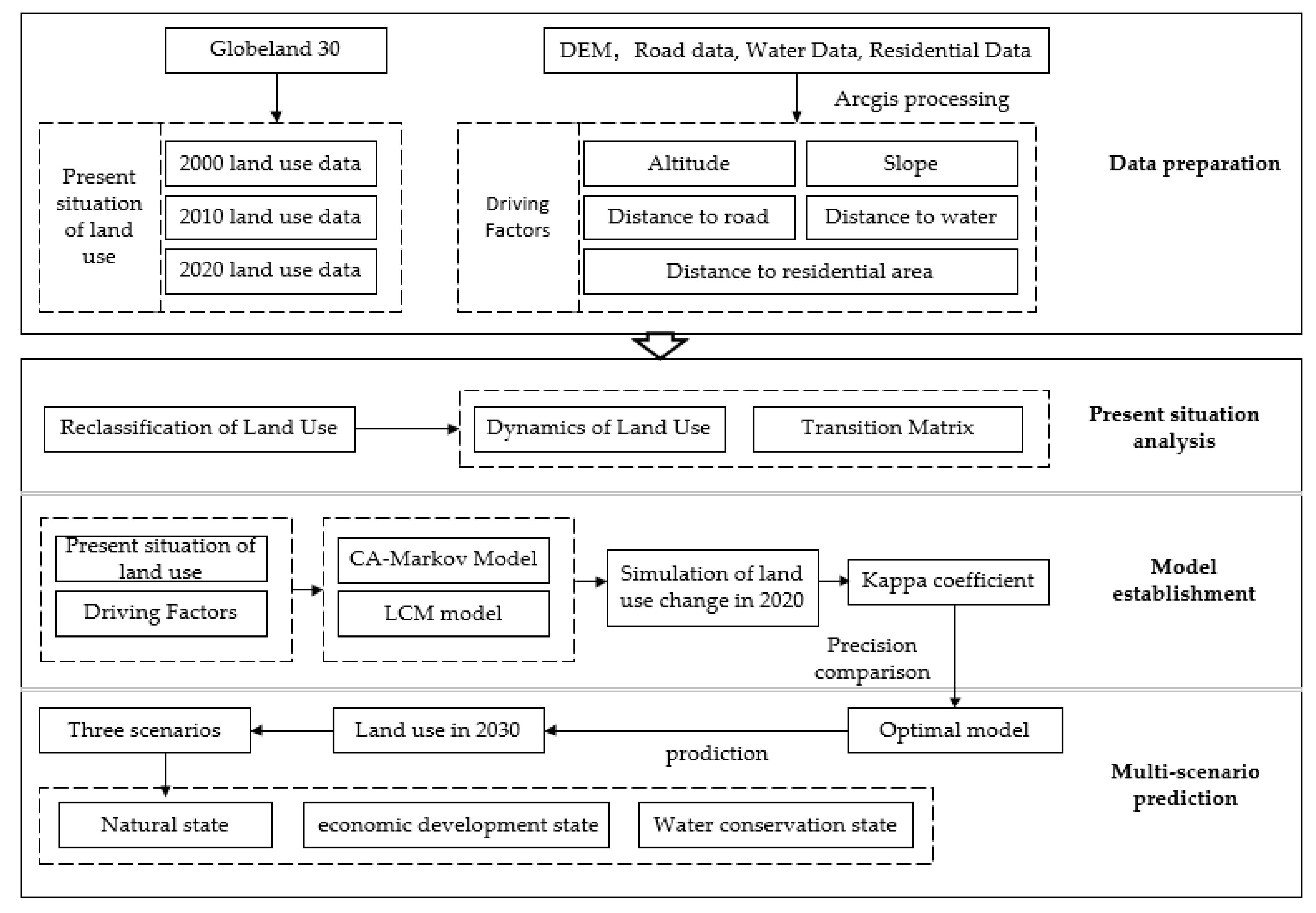
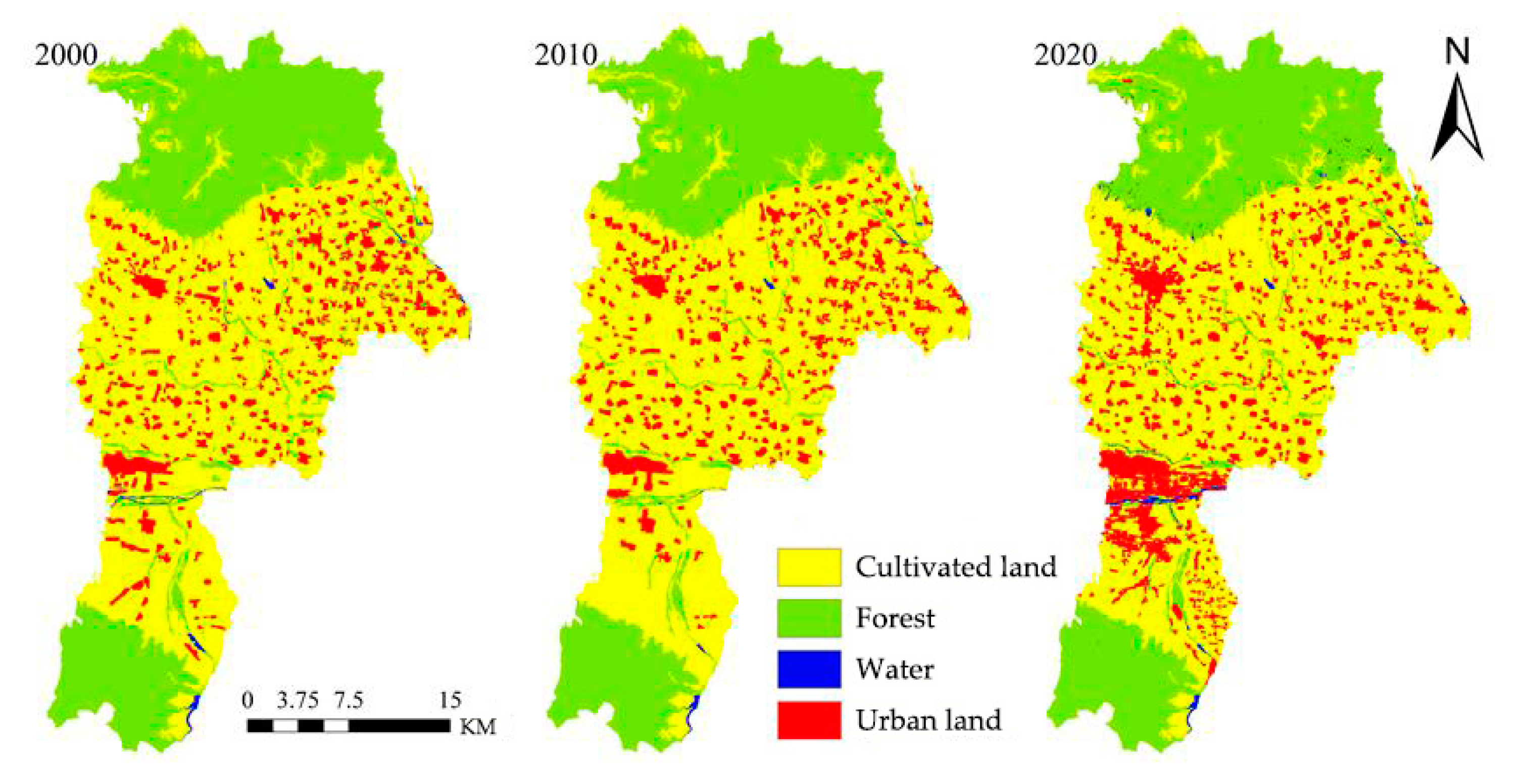
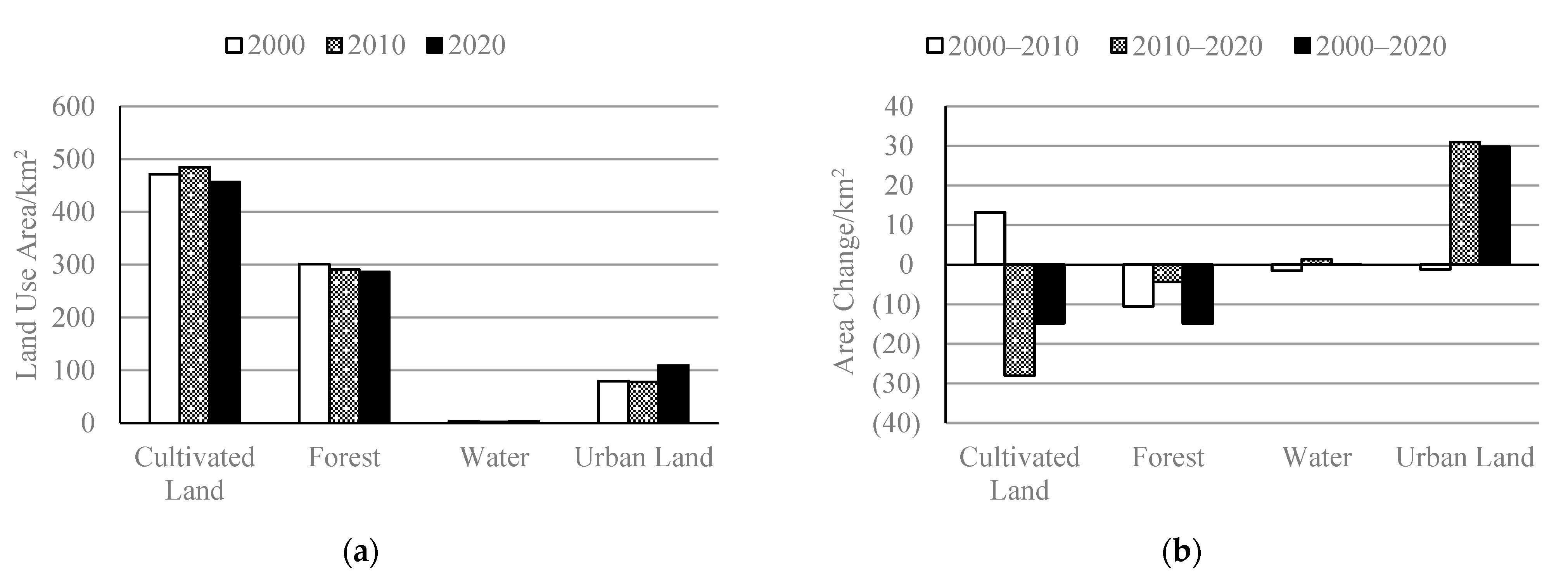
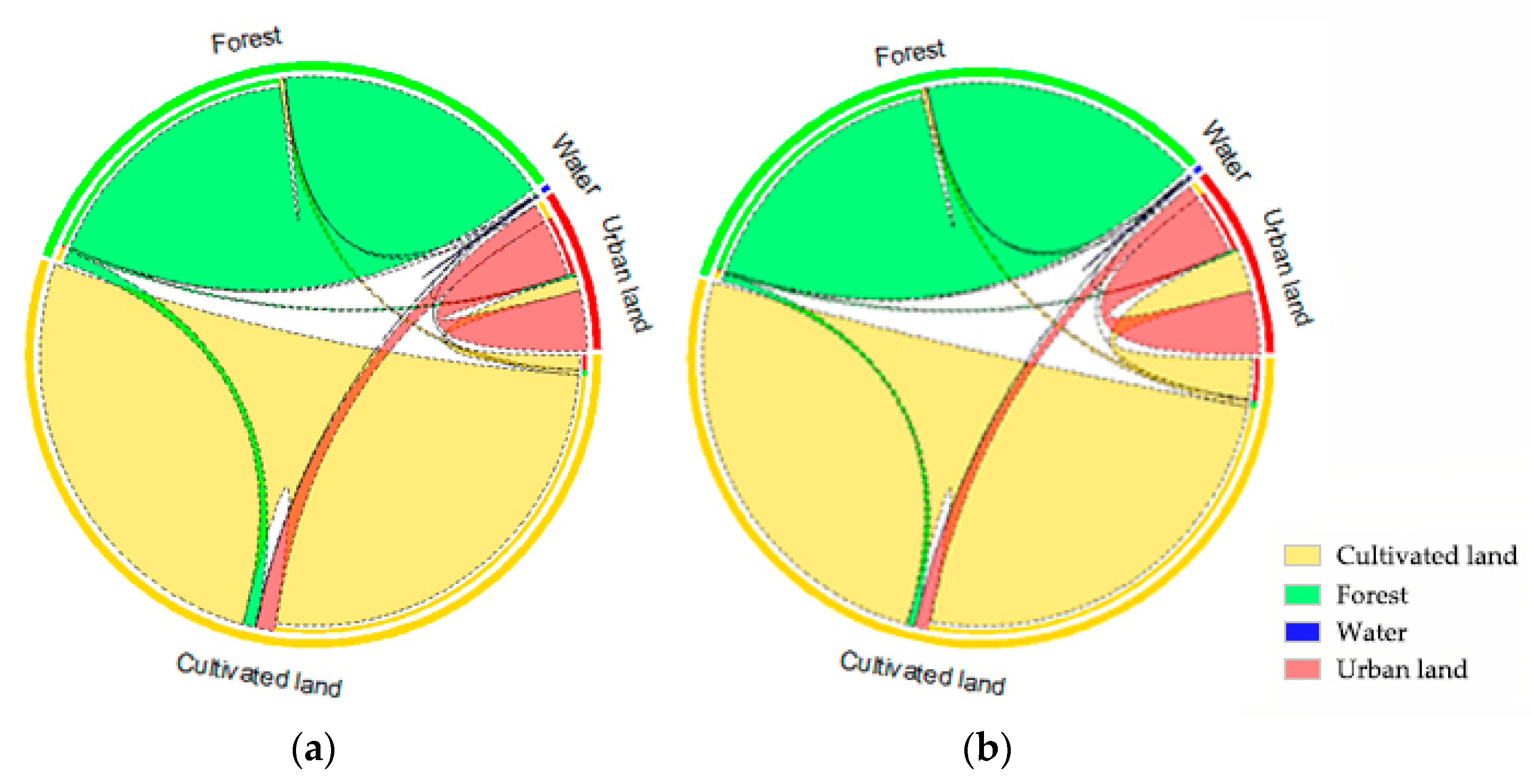




| Data Type | Data Name | Data Resource |
|---|---|---|
| Land cover data | Land cover data in 2000, 2010, 2020 | http://globeland30.org/ (accessed on 10 October 2021). |
| Natural factor | Altitude | https://earthexplorer.usgs.gov/ (accessed on 10 October 2021). |
| Slope | Extracted from altitude image | |
| Accessibility factor | Road distance | Euclidean distance from roads which deserved form National Catalogue Service for Geographic Information |
| Water distance | Euclidean distance from water areas which deserved form National Catalogue Service for Geographic Information | |
| Residential area distance | Euclidean distance from residential areas which deserved form National Catalogue Service for Geographic Information |
| Classification | Original Land Use Type | |
|---|---|---|
| 1 | Cultivated land | Cultivated land |
| 2 | Forest | Woodland, grassland, shrub land |
| 3 | Water | River, wetland |
| 4 | Urban land | Urban land |
| Land Use Type | Single Dynamic Degree | Comprehensive Dynamic Degree | ||||
|---|---|---|---|---|---|---|
| 2000–2010 (%) | 2010–2020 (%) | 2000–2010 (%) | 2000–2010 (%) | 2010–2020 (%) | 2000–2020 (%) | |
| Cultivated land | 0.28 | −0.58 | 0.43 | 0.43 | 1.02 | 0.59 |
| Forest | −0.35 | −0.15 | 0.54 | 0.54 | 0.36 | 0.40 |
| Water | −4.63 | 8.02 | 5.08 | 5.08 | 1.62 | 2.52 |
| Urban land | −0.15 | 3.98 | 2.46 | 2.46 | 1.82 | 1.46 |
| Land Use Type | Driving Force 1 | Driving Force 2 | Driving Force 3 |
|---|---|---|---|
| Cultivated land | Slope 0.6 | Altitude 0.2 | Water distance 0.2 |
| Forest | Altitude 0.6 | Slope 0.4 | - |
| Water | Water distance 1 | - | - |
| Urban land | Slope 0.43 | Road distance 0.42 | Residential area distance 0.15 |
| Num | Accuracy (%) | Transfer Type |
|---|---|---|
| 1 | 76.39 | Forest→Cultivated land |
| Forest→Urban land | ||
| 2 | 66.48 | Cultivated land→Forest |
| 3 | 90.23 | Cultivated land→Urban land |
| 4 | 79.24 | Urban land→Cultivated land |
| Land Use Type | Reference | Natural State (km2) | Economic Development (km2) | Water Area Protection (km2) |
|---|---|---|---|---|
| Cultivated land | Area | 437.13 | 433.11 | 436.88 |
| Change | −19.57 | −23.59 | −19.82 | |
| Forest | Area | 282.12 | 281.88 | 281.89 |
| Change | −4.38 | −4.63 | −4.62 | |
| Water | Area | 4.26 | 4.25 | 4.77 |
| Change | 1.12 | 1.11 | 1.62 | |
| Urban land | Area | 131.62 | 135.90 | 131.60 |
| Change | 22.83 | 27.11 | 22.82 |
Publisher’s Note: MDPI stays neutral with regard to jurisdictional claims in published maps and institutional affiliations. |
© 2022 by the authors. Licensee MDPI, Basel, Switzerland. This article is an open access article distributed under the terms and conditions of the Creative Commons Attribution (CC BY) license (https://creativecommons.org/licenses/by/4.0/).
Share and Cite
Xiong, N.; Yu, R.; Yan, F.; Wang, J.; Feng, Z. Land Use and Land Cover Changes and Prediction Based on Multi-Scenario Simulation: A Case Study of Qishan County, China. Remote Sens. 2022, 14, 4041. https://doi.org/10.3390/rs14164041
Xiong N, Yu R, Yan F, Wang J, Feng Z. Land Use and Land Cover Changes and Prediction Based on Multi-Scenario Simulation: A Case Study of Qishan County, China. Remote Sensing. 2022; 14(16):4041. https://doi.org/10.3390/rs14164041
Chicago/Turabian StyleXiong, Nina, Rongxia Yu, Feng Yan, Jia Wang, and Zhongke Feng. 2022. "Land Use and Land Cover Changes and Prediction Based on Multi-Scenario Simulation: A Case Study of Qishan County, China" Remote Sensing 14, no. 16: 4041. https://doi.org/10.3390/rs14164041
APA StyleXiong, N., Yu, R., Yan, F., Wang, J., & Feng, Z. (2022). Land Use and Land Cover Changes and Prediction Based on Multi-Scenario Simulation: A Case Study of Qishan County, China. Remote Sensing, 14(16), 4041. https://doi.org/10.3390/rs14164041






